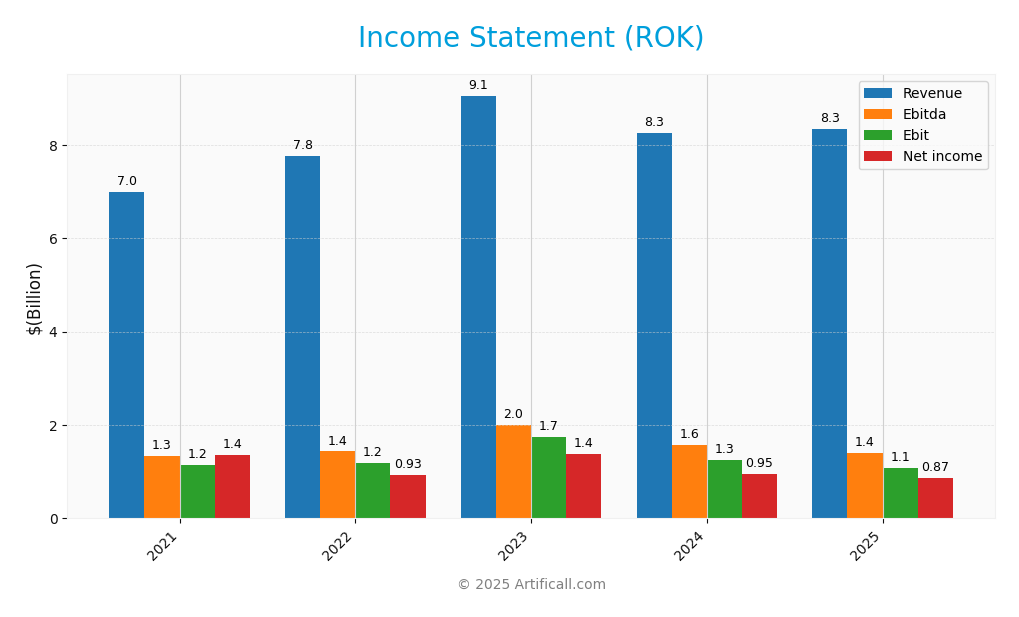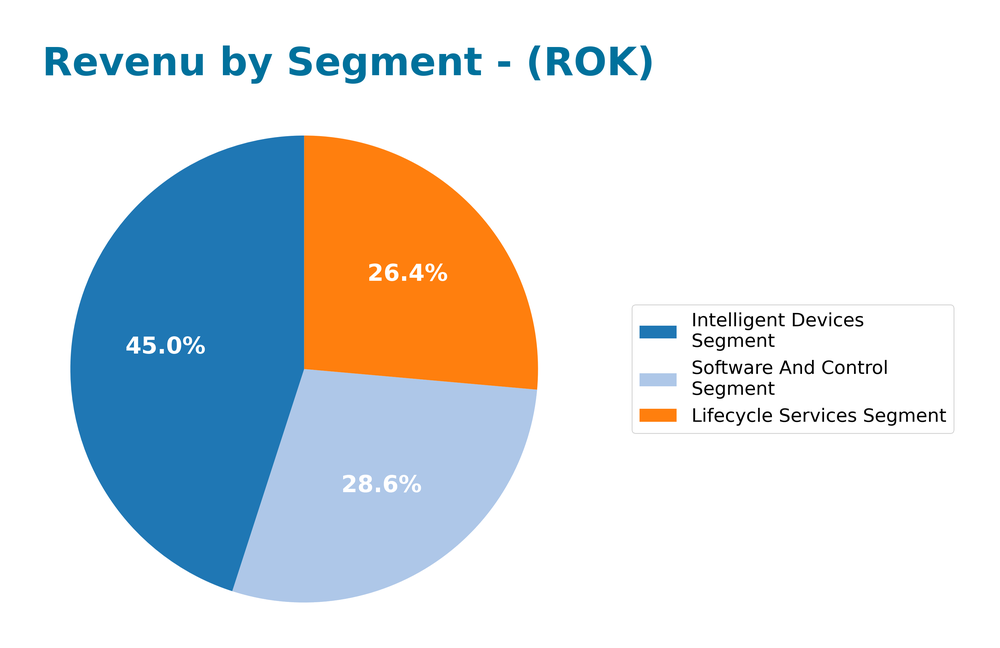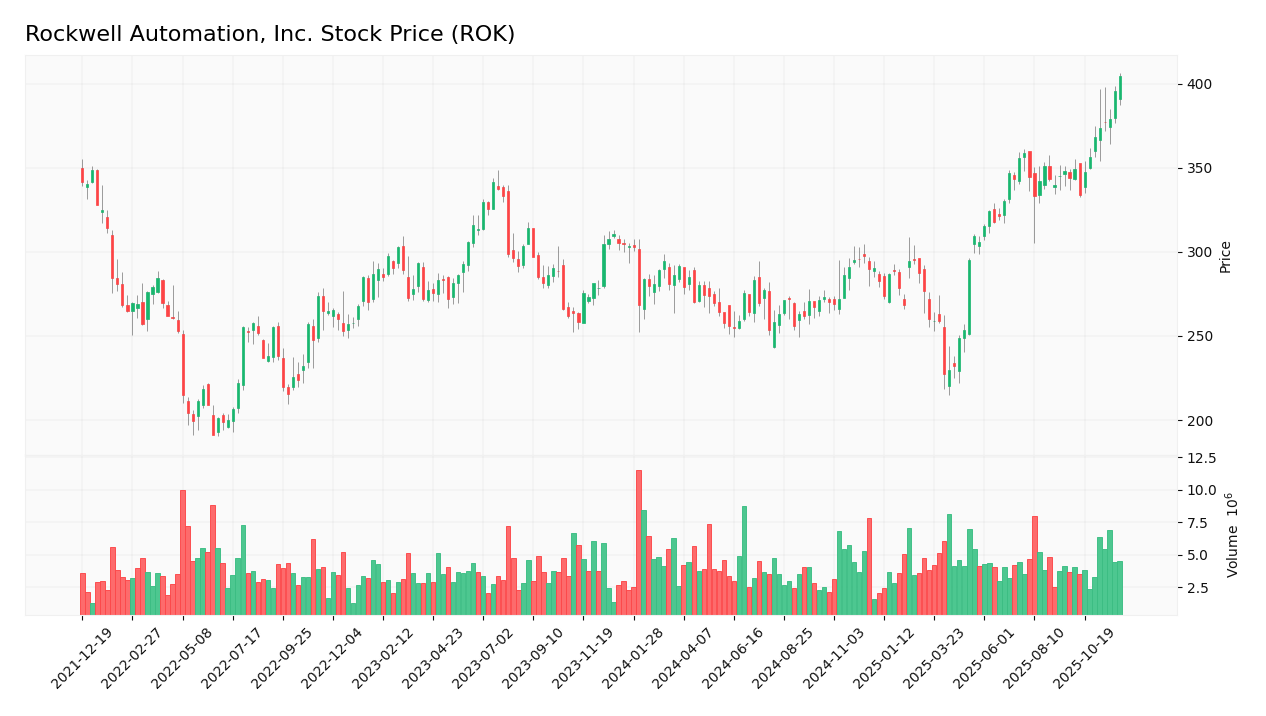In a world increasingly driven by automation and digital transformation, Rockwell Automation, Inc. stands at the forefront, revolutionizing how industries operate. With its cutting-edge solutions across industrial automation, the company excels in delivering innovative hardware, software, and services that enhance productivity and efficiency. Renowned for its quality and market influence, Rockwell has established a strong reputation, serving diverse sectors from automotive to renewable energy. As we delve into the investment analysis, one must consider whether Rockwell’s robust fundamentals continue to justify its current market valuation and growth trajectory.

Table of contents
Company Description
Rockwell Automation, Inc. is a prominent player in the industrial automation and digital transformation sector, serving a diverse range of markets worldwide. Founded in 1903 and headquartered in Milwaukee, Wisconsin, the company operates through three key segments: Intelligent Devices, Software & Control, and Lifecycle Services. Rockwell’s offerings include advanced hardware and software solutions, with products such as drives, safety systems, and control software tailored for various industries, including automotive, food and beverage, and renewable energy. As a leader in automation, Rockwell is strategically positioned to shape industry standards and drive innovation, focusing on enhancing operational efficiency and sustainability efforts across its global customer base.
Fundamental Analysis
In this section, I will conduct a fundamental analysis of Rockwell Automation, covering its income statement, financial ratios, and dividend payout policy.
Income Statement
The following table presents Rockwell Automation, Inc.’s income statement for the fiscal years 2021 through 2025, highlighting key financial metrics.

| Metric | 2021 | 2022 | 2023 | 2024 | 2025 |
|---|---|---|---|---|---|
| Revenue | 6.997B | 7.760B | 9.058B | 8.262B | 8.342B |
| Cost of Revenue | 4.100B | 4.658B | 5.341B | 4.584B | 4.326B |
| Operating Expenses | 2.168B | 1.767B | 2.024B | 2.414B | 2.594B |
| Gross Profit | 2.898B | 3.102B | 3.717B | 3.679B | 4.016B |
| EBITDA | 1.330B | 1.436B | 1.994B | 1.568B | 1.398B |
| EBIT | 1.152B | 1.198B | 1.743B | 1.250B | 1.073B |
| Interest Expense | 0.093B | 0.120B | 0.132B | 0.151B | 0.156B |
| Net Income | 1.358B | 0.932B | 1.387B | 0.953B | 0.869B |
| EPS | 11.69 | 8.02 | 12.03 | 8.32 | 7.69 |
| Filing Date | 2021-11-09 | 2022-11-08 | 2023-11-08 | 2024-11-12 | 2025-11-12 |
Interpretation of Income Statement
Over the five-year period, Rockwell Automation, Inc. experienced a steady increase in revenue from 6.997B in 2021 to 8.342B in 2025, although growth has shown signs of slowing in recent years. Net income peaked in 2023 at 1.387B, but has since declined to 869M in 2025, reflecting tighter profit margins and increasing operational costs. The gross profit margin has remained relatively stable, indicating consistent pricing power, but the drop in EBITDA and net income in 2025 suggests potential challenges in managing expenses effectively amidst fluctuating revenues.
Financial Ratios
The following table presents the key financial ratios for Rockwell Automation, Inc. (ROK) for the years 2022, 2023, 2024, and 2025.
| Ratios | 2022 | 2023 | 2024 | 2025 |
|---|---|---|---|---|
| Net Margin | 11.84% | 15.26% | 11.53% | 0% |
| ROE | 33.72% | 38.79% | 27.23% | 0% |
| ROIC | 13.65% | 16.16% | 12.39% | 0% |
| P/E | 27.13 | 23.76 | 32.13 | 0 |
| P/B | 9.15 | 9.21 | 8.75 | 0 |
| Current Ratio | 1.01 | 1.46 | 1.08 | 2.37 |
| Quick Ratio | 0.72 | 1.04 | 0.72 | 1.56 |
| D/E | 1.53 | 0.94 | 1.17 | 0.97 |
| Debt-to-Assets | 38.88% | 29.50% | 36.37% | 31.67% |
| Interest Coverage | 10.98 | 12.54 | 8.37 | 0 |
| Asset Turnover | 0.72 | 0.80 | 0.74 | – |
| Fixed Asset Turnover | 8.55 | 8.76 | 6.89 | – |
| Dividend Yield | 2.08% | 1.65% | 1.87% | 0% |
Interpretation of Financial Ratios
Analyzing Rockwell Automation, Inc. (ROK) as of FY 2025 reveals a mixed financial health profile. The current ratio of 2.37 indicates strong liquidity, suggesting that the company can cover its short-term liabilities easily. The quick ratio of 1.56 further supports this, showing good liquidity without reliance on inventory. However, the solvency ratio is 0, indicating a complete lack of equity financing, which raises concerns about long-term financial stability. Profitability ratios are also absent, suggesting the company may not be generating profits effectively. The debt ratios, including a debt-to-equity ratio of 0.97, show moderate leverage, but the absence of profitability metrics could pose significant risks.
Evolution of Financial Ratios
Over the past five years, Rockwell Automation’s financial ratios show a concerning decline, particularly in profitability metrics which have dropped to zero in 2025 from previously positive levels. While liquidity has remained strong, the lack of profitability and solvency highlights increasing financial risks.
Distribution Policy
Rockwell Automation, Inc. does not currently pay dividends, reflecting its strategy focused on reinvestment and growth. The company is likely prioritizing investments in research and development, aiming to enhance its competitive edge in automation solutions. While there are no dividends, Rockwell has engaged in share buybacks, indicating a commitment to returning value to shareholders. This approach, if managed prudently, can support sustainable long-term value creation by enhancing shareholder equity and fostering growth.
Sector Analysis
Rockwell Automation, Inc. operates in the industrial machinery sector, focusing on automation and digital transformation solutions. Its key strengths include a diverse product range and strong positioning against competitors.
Strategic Positioning
Rockwell Automation, Inc. (ROK) occupies a significant position in the industrial automation market, with a market cap of approximately $45.4B. The company competes effectively through its three primary segments: Intelligent Devices, Software & Control, and Lifecycle Services. With a beta of 1.499, ROK is subject to competitive pressures and market volatility. Technological disruption, particularly in digital transformation solutions, poses both challenges and opportunities. As industries increasingly adopt automation, Rockwell’s ability to innovate and adapt will be crucial to maintaining and expanding its market share.
Revenue by Segment
The following chart illustrates Rockwell Automation’s revenue distribution by segment for the fiscal year 2025, showcasing how each segment contributes to the overall financial performance.

In FY 2025, Rockwell Automation’s revenue is primarily driven by the Intelligent Devices Segment, generating $3.76B, followed by Lifecycle Services at $2.20B and Software and Control at $2.38B. Overall, there is a slight decline in revenue for the Intelligent Devices Segment compared to FY 2024, indicating potential market saturation or increased competition. Notably, the Software and Control Segment experienced growth, highlighting a strategic shift towards software solutions. This diversification may mitigate risks and enhance margins moving forward.
Key Products
Rockwell Automation, Inc. provides a diverse range of products that cater to various industrial automation needs. Below is a table summarizing some of their key products:
| Product | Description |
|---|---|
| Intelligent Devices | This segment includes hardware solutions such as drives, motion components, safety devices, and industrial sensors, designed to optimize manufacturing processes. |
| Control Software | Offers advanced control and visualization software that enhances operational efficiency and provides real-time data analytics. |
| Digital Twin Solutions | A simulation software that creates a digital replica of physical assets, allowing for predictive maintenance and improved design processes. |
| Lifecycle Services | Provides consulting, professional services, and maintenance solutions to ensure the longevity and efficiency of automation systems. |
| Network and Security Solutions | Infrastructure solutions that safeguard industrial networks against cyber threats while ensuring reliable communication across systems. |
These products collectively support a wide array of industries, demonstrating Rockwell Automation’s commitment to driving digital transformation and operational excellence.
Main Competitors
The competitive landscape for Rockwell Automation, Inc. includes several key players in the industrial machinery sector. Below is a table of the main competitors sorted by market capitalization:
| Company | Market Cap |
|---|---|
| Roper Technologies, Inc. | 48.2B |
| Fastenal Company | 47.6B |
| W.W. Grainger, Inc. | 46.4B |
| AMETEK, Inc. | 46.1B |
| Rockwell Automation, Inc. | 45.4B |
| Waste Connections, Inc. | 44.6B |
| HEICO Corporation | 43.4B |
| Paychex, Inc. | 40.4B |
| Otis Worldwide Corporation | 34.1B |
| Xylem Inc. | 33.8B |
| Ingersoll Rand Inc. | 31.6B |
These companies operate primarily in the North American market, competing across various segments of industrial automation and machinery. Each competitor offers unique solutions and services that contribute to the overall dynamics of the industry.
Competitive Advantages
Rockwell Automation, Inc. (ROK) leverages its extensive portfolio of industrial automation solutions to maintain a competitive edge in the market. With a robust focus on innovation, the company is poised to introduce new products in intelligent devices and software, enhancing operational efficiency for clients across diverse sectors. As industries increasingly embrace digital transformation, Rockwell has the opportunity to expand into emerging markets, particularly in renewable energy and smart manufacturing. This strategic positioning not only enhances revenue potential but also solidifies Rockwell’s role as a leader in the automation space, ensuring long-term growth and sustainability.
SWOT Analysis
The purpose of this analysis is to evaluate the key factors influencing Rockwell Automation, Inc. (ROK) to inform strategic decision-making.
Strengths
- Strong market position
- Diverse product portfolio
- Established brand reputation
Weaknesses
- High dependency on industrial sectors
- Limited geographic diversification
- Significant competition
Opportunities
- Growth in automation demand
- Expansion into emerging markets
- Advancements in technology
Threats
- Economic downturns
- Supply chain disruptions
- Regulatory challenges
Overall, the SWOT assessment indicates that while Rockwell Automation has solid strengths and opportunities for growth, it must navigate notable weaknesses and external threats. A strategic focus on innovation and market expansion will be crucial for sustained success.
Stock Analysis
Over the past year, Rockwell Automation, Inc. (Ticker: ROK) has experienced significant price movements, with a notable bullish trend characterized by a 32.73% increase in stock price.

Trend Analysis
Analyzing the stock’s performance over the past year, I observed a price change of 32.73%, indicating a bullish trend. The stock has shown acceleration in its upward movement, with notable highs reaching 404.29 and lows at 227.11. The standard deviation of 38.26 suggests a level of volatility, which is typical in a bullish market but warrants caution.
Volume Analysis
In the last three months, Rockwell Automation has exhibited an increasing volume trend, with total trading volume at approximately 517.4M. Buyer-driven activity is evident, with buyer volume at 291.7M compared to seller volume at 222.9M, leading to a buyer dominance percentage of 56.38%. Recent data shows even stronger buyer sentiment, with 86.3% of the volume being buyer-driven, further reinforcing positive investor sentiment in the market.
Analyst Opinions
Recent analyst recommendations for Rockwell Automation, Inc. (ROK) have been cautious, with a consensus rating of “Sell.” Analysts highlight concerns over the company’s low scores in key financial metrics, including return on equity and debt-to-equity ratios. The overall rating stands at C-, indicating significant risks in the current market environment. Notable analysts, including those from major investment firms, emphasize the need for strategic improvements before considering a buy. As of now, I would advise caution for investors looking at ROK for their portfolios.
Stock Grades
The latest stock ratings for Rockwell Automation, Inc. (ROK) show a consistent outlook from several reputable grading companies.
| Grading Company | Action | New Grade | Date |
|---|---|---|---|
| Barclays | maintain | Overweight | 2025-12-04 |
| Baird | maintain | Outperform | 2025-11-21 |
| B of A Securities | maintain | Buy | 2025-11-20 |
| JP Morgan | maintain | Neutral | 2025-11-11 |
| Morgan Stanley | maintain | Overweight | 2025-11-10 |
| Barclays | maintain | Overweight | 2025-11-07 |
| Wells Fargo | maintain | Equal Weight | 2025-11-07 |
| JP Morgan | maintain | Neutral | 2025-10-15 |
| Oppenheimer | maintain | Outperform | 2025-10-14 |
| Wells Fargo | maintain | Equal Weight | 2025-10-06 |
Overall, the trend indicates a stable sentiment towards ROK, with multiple firms maintaining their positive ratings, suggesting a robust outlook for the company moving forward.
Target Prices
The consensus target price for Rockwell Automation, Inc. (ROK) reflects a positive outlook among analysts.
| Target High | Target Low | Consensus |
|---|---|---|
| 402 | 345 | 377.6 |
Overall, analysts expect Rockwell Automation’s stock to trade around the consensus price of 377.6, indicating a balanced view between its highest and lowest targets.
Consumer Opinions
Consumer sentiment about Rockwell Automation, Inc. (ROK) reflects a mix of praise for their innovation and concerns regarding customer service.
| Positive Reviews | Negative Reviews |
|---|---|
| “Exceptional product quality and reliability.” | “Customer service response times are slow.” |
| “Innovative solutions that drive efficiency.” | “High costs make it less accessible for small businesses.” |
| “Strong reputation in automation technology.” | “Some products have complex installation processes.” |
| “Excellent technical support from knowledgeable staff.” | “Occasional software bugs that need updates.” |
Overall, consumer feedback highlights Rockwell’s strong product quality and innovative solutions, while also noting concerns about customer service responsiveness and the cost of products.
Risk Analysis
In this section, I will outline the key risks associated with investing in Rockwell Automation, Inc. (ROK) to provide a clear understanding of potential challenges.
| Category | Description | Probability | Impact |
|---|---|---|---|
| Market Volatility | Fluctuations in the stock market affecting ROK’s share price. | High | High |
| Supply Chain Disruptions | Risks related to sourcing materials and components. | Medium | High |
| Regulatory Changes | New regulations impacting operations and costs. | Medium | Medium |
| Technological Advancements | Rapid changes in technology requiring constant innovation. | High | Medium |
| Economic Downturn | A recession affecting customer demand for automation solutions. | Medium | High |
The most likely and impactful risks for ROK include market volatility and economic downturns, which have been exacerbated by recent global economic uncertainties. It is essential to stay informed and manage these risks effectively.
Should You Buy Rockwell Automation, Inc.?
Rockwell Automation, Inc. (ROK) has demonstrated a positive revenue growth with a total revenue of 8.34B in 2025, reflecting an increase compared to previous years. However, the company’s return on invested capital (ROIC) is 10.3%, which is lower than its weighted average cost of capital (WACC) at 10.3%, indicating value destruction. The total debt stands at 3.65B, resulting in a debt-to-equity ratio of 0.80, which suggests a moderate level of leverage. The overall rating for ROK is a C-, which could imply potential concerns regarding its fundamentals and value creation.
Favorable signals
In the financial evaluation of Rockwell Automation, Inc. (ticker: ROK), I identified several favorable elements. The gross margin stands at 48.14%, indicating a strong ability to manage production costs relative to revenue. Additionally, the gross profit growth of 9.17% and an EBIT margin of 12.86% also suggest operational efficiency. The interest expense as a percentage of revenue is relatively low at 1.87%, and the company maintains a favorable current ratio of 2.37 and quick ratio of 1.56, reflecting good short-term liquidity.
Unfavorable signals
Despite these favorable aspects, there are notable unfavorable signals in the data. The revenue growth rate of 0.97% is disappointing, and the EBIT growth is notably negative at -14.17%. Furthermore, the net margin growth is also negative at -9.64%, alongside a stagnant net margin of 0%. Both the return on invested capital (ROIC) and return on equity (ROE) are at 0%, which indicates a lack of effective capital utilization. Additionally, the company’s weighted average cost of capital (WACC) is quite high at 10.3%, suggesting difficulties in generating returns that exceed this cost.
Conclusion
Considering the mixed signals from the evaluation, with unfavorable ratios and a neutral opinion on the income statement, it might be prudent to wait for clearer indicators before making any investment decisions regarding ROK. Recent selling activity exceeds buying, which could suggest the need for buyers to return for a more favorable outlook.
Disclaimer: This article is not financial advice. Each investor is responsible for their own investment decisions.
Additional Resources
- VP Perducat Acquires 864 Of Rockwell Automation Inc [ROK] – TradingView (Dec 06, 2025)
- Rockwell Automation, Inc. (ROK) Hit a 52 Week High, Can the Run Continue? – Yahoo Finance (Dec 01, 2025)
- Rockwell Automation VP Woods sells $27,396 in shares – Investing.com (Dec 06, 2025)
- Barclays Maintains Rockwell Automation (ROK) Overweight Recommendation – Nasdaq (Dec 05, 2025)
- Norges Bank Buys New Holdings in Rockwell Automation, Inc. $ROK – MarketBeat (Dec 02, 2025)
For more information about Rockwell Automation, Inc., please visit the official website: rockwellautomation.com



